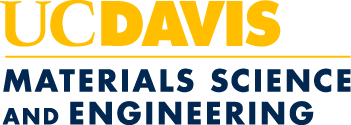Safety Information for all Materials Science and Engineering Laboratories
The Department of Materials Science and Engineering is dedicated to maximizing the safety of all faculty, staff and students. This page contains forms and information related to laboratory safety within the department. For any safety-related issues or questions, please don’t hesitate to contact the department safety coordinator (DSC):

Bill Doering
Department Safety Coordinator
3316 Bainer Hall
wdoering@ucdavis.edu
530-752-2509
Department Safety Documents
- Injury and illness prevention plan (IIPP).
- Emergency action plan (EAP).
- Incident report.
- Site-specific safety orientation form.
- Annual training documentation.
- Laboratory orientation and key authorization form.
Additional Documents/Resources
- Campus Laboratory Safety Manual.
- Guidelines for chemical spill control.
- Campus-required standard operating procedures (SOPs).
- SOP templates.
- Laboratory safety review checklist.
- CUPA self-audit checklist.
- Safety Training Matrix.
- Hazard communication (HazCom).
- Emergency eyewash and shower testing.
- Injury reporting/emergency medical care.
- UC Davis Safety Services homepage.
Required Safety Training
Safety training requirements for research labs
In addition to the departmental safety training, all faculty, students and employees that work in research laboratories are required to complete the following trainings before unsupervised activities are permitted:
- UC Laboratory Safety Fundamentals course, an online training course covering general lab safety.
- Lab-specific orientation, which covers emergency procedures, engineering controls, personal protective equipment (PPE), standard operating procedures (SOPs) and other safety information that is specific to each lab or PI. This will be arranged with your lab safety coordinator.
- Annual, documented refresher training provided by each lab that covers chemical spill control, hazardous waste management and emergency procedures.
- Additional training for research that presents unique hazards, including the use of radioactive or biological materials or research lasers. Refer to the Safety Training Matrix to help you determine if any other trainings are required or applicable.
Finally, a laboratory orientation and key authorization form must be signed by your professor (PI) for you to receive a key and/or access code to the lab.
Safety records
Every lab is required to maintain up-to-date records of the following:
- Chemical hygiene plan, which is included in the UC Davis Laboratory Safety Manual.
- Chemical inventory. Note that you must conduct the CUPA lab self-inspection in order to complete the online chemical inventory process.
- Safety data sheets (SDS) for each chemical in the lab. These may be stored electronically or as hard copies, but must be freely accessible to anybody entering the lab.
- Emergency eyewash and shower testing record, if applicable.
- Fire extinguisher monthly checks.
- Standard operating procedures (SOPs) and documented training for authorized users.
All labs must also perform annual “self-audits” of their laboratories using the CUPA checklist and the self-inspection form:
Assistance for self-audits is available upon request. Please contact your lab safety coordinator to set up an appointment.
FAQs
- Who is the best contact in Safety Services to answer my question about X?
- Please refer to the official Safety Services call list.
- Where can I find campus policies that pertain to safety?
- -- UCOP laboratory safety policies.
-- UC Davis chemical and laboratory safety policies.
-- UC Davis research policies, regulations and guidelines. - I was injured at work. What do I do now?
- In the event of an emergency, dial 911. Work-related injuries or illnesses must be immediately reported to Worker’s Compensation using the injury reporting procedure.
- I have a safety concern, suggestion, incident or hazard to report. What do I do?
- If you witness a safety hazard and can take action to correct it or prevent others from encountering the hazard, please do so immediately. You can also use the UC Davis online reporting tool or report it to the department safety coordinator.
- How do I obtain/choose/launder personal protective equipment (PPE)?
Procurement of new PPE can be done through Vet Med Central Services. PPE can be reassigned or obtained through other means. However, it is important that PPE distribution is documented and that PPE obtained from other sources is appropriate for the task.
Here is a guide to help you select the most appropriate PPE.
Lab coats can be laundered by dropping them off with the College of Engineering’s receiving dock at Bainer 1334. The first time they are dropped, you will need to fill out and attach a tag with some information about the coat. This information will be linked to another bar code that will be attached to the coat.
As of now, the College is covering the costs. Coats are picked up every Thursday. They should be returned the following week, but please keep track of drop-offs, as coats occasionally go missing. If you don’t get yours back, the vendor can search for its location and provide a replacement if it cannot be found.
Check out the Vet Med website for a much longer list of PPE FAQs.
- What is the campus process if I need to use a respirator or N95 mask?
- Steps for obtaining and fitting a respirator can be found on the Safety Services website.
- How do I dispose of waste?
- Hazardous waste is managed using the electronic WASTe tool. Guidelines for hazardous waste can be found on the Safety Services website. Please note that acutely or extremely hazardous waste has special rules. These rules can be found on the guidelines for hazardous waste page.
- How do I get rid of empty chemical containers, bottles and/or broken lab glass?
- The container must be completely empty and the label must be defaced. They can be recycled or put into a lab glass box. If the empty container is greater than five gallons, you must write the date it was emptied on the container. You must dispose of them through Environmental Health & Safety if the container held an acutely or extremely hazardous material.
All broken lab glass should be put into a lab glass box. When the box is full, it should be sealed and marked as “clean lab glass.” Custodial services should take it away if it weighs under 40 lbs.
More complete information is available here:
-- Guidelines for disposal of sharps, biological and medical waste.
-- Empty container management.
-- Why didn’t the custodian pick up my trash? - I’m having a building-related problem. What do I do?
- If it’s urgent, call the facilities work-order desk at 530-752-1655. Select option No. 1 and report the problem to the dispatch operator. If it’s not urgent, you can either place a work order by calling 530-752-1655, or you can consult with the department safety coordinator to determine the best course of action.
- I just started working for the department. What safety training do I need?
- For departmental trainings, check with the department safety coordinator (DSC). For special work functions, you may need additional training.
- What safety documentation must my lab maintain?
- -- Initial and annual refresher training for every lab member covering:
1. Department IIPP.
2. Department EAP.
3. Emergency and evacuation training.
4. Chemical spill training.
5. Hazardous waste management.
6. The current UC Davis Lab Safety Manual, which also contains the campus chemical hygiene plan.
7. Any applicable SOPs that have been revised.
8. A site-specific laboratory safety plan (LSP), which is likely to apply to many research labs.
-- All campus-required SOPs must be implemented and trained upon if they apply in your lab.
-- Chemical inventory must be updated. Safety data sheets (SDS) must exist for all hazardous materials in your lab and in your inventory.
-- LHAT review training is required if hazards have changed.
-- The current Lab Safety Manual must be available to all lab members. - Do you have a complete list of the safety training courses offered by UC Davis?
- The complete list of safety training courses can be found on the Safety Services website.
Refresher training is required annually for:
-- Departmental safety training (covering the department’s injury and illness prevention plan and emergency action plan), conducted by Bill Doering.
-- Hazard communication training (required only for faculty, students and staff who do not work in experimental labs but will be handling, using or storing hazardous materials).
-- Each lab’s chemical spill control, hazardous waste management and emergency procedures.
Refresher training is required every three years for the UC Laboratory Safety Fundamentals course. - Where can I find information about office ergonomics?
- You can find information about office ergonomics at ehs.ucdavis.edu/article/uc-davis-office-ergonomics.
- Does my workspace need to take part in the Shop Safety Program?
- Refer to the UC Davis Shop Safety Manual to determine if you have equipment that falls under the Shop Safety Program. If so, you must implement an appropriate shop safety plan.

